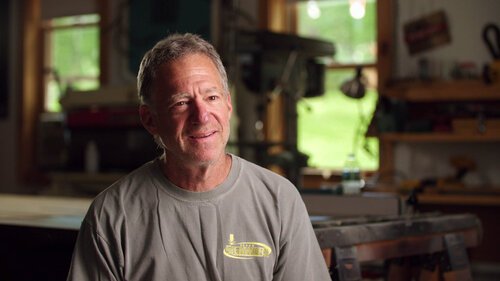How (and Why) We Created a DIY Interrotron
Last February, during a particularly slow part of the year, Meag and I set out to create as many short form documentaries as we could in one long weekend. Our first of three led us to our friend Sarah Patridge’s newly opened tattoo studio, Polychrome. Her committed efforts towards inclusiveness, and making her establishment warm and inviting for all patrons intrigued us. When we met with her for a pre-interview, it was obvious she had immense love for her craft and clientele. We wanted to tell her story, and make sure viewers could experience the same earnestness we did speaking with her in person. To achieve this, we decided on a unique documentary device we haven’t used too often in our own work: The Interrotron.
It sounds like a villainous robot from an old radio drama, but in reality it’s a pretty simple concept. An Interrotron is a device (invented by legendary documentary filmmaker Errol Morris) that creates an eye line for a subject to look directly into the lens, and thus what is captured is a more intimate interview than the typical off-camera eye line that is more prevalent in the documentary world. It’s basically a hyper-localized FaceTime for documentarians.
Traditional documentary interview set up where the subject’s eye line is just off camera (as seen in our documentary “The Walldogs Create the Magical History Tour”).
The Interrotron set up we used with Sarah, where she is looking right into the lens, giving the effect of looking at the viewer.
The technical specification of the device may have changed over the years (when Morris created it, heavy CRTs were the only available solution), but the concept remains the same: a projection of the interviewer sits over the lens (by reflection of a two-way mirror), and the interviewee speaks to the projection, as if they were speaking directly to someone, like a video chat. The interviewer speaks to a monitor which has a feed from the camera (and a camera mounted somewhere to match the eye line so it looks like they’re looking in to each other’s eyes). The end result is a recorded interview that feels as though the subject is talking directly to the viewer.
Why would you need a special device? Why not just tell the interviewee to talk directly into the lens?
For the most part we’ve found documentary subjects to have little to no experience on camera. Pouring your heart out to the lens, while being cognizant of your eye line, is usually reserved for seasoned actors/presenters, and even then there will be a level of artificiality attached to looking into a big piece of glass rather than the interviewer’s eyes. We connect with eye line; it’s an important communication device in itself. An interviewer (especially in film) needs to utilize every silent means of communication we have available. The head nod, the silent chuckle, the quizzical brow-crinkle—all of these body movements help reflect the interviewees energy without ruining audio/video components of the recording. And of course, reciprocating communication is what makes any conversation thrive.
Errol Morris has a history of true crime documentaries, so it’s easy to associate the technique with criminal interrogation (after all, it’s in the name). But that doesn’t do justice to the power of the technique. We didn’t make a gritty true crime documentary, but we were still able to utilize the technique to convey a truth about our subject.
What was our Interrotron build?
When we set out on our long weekend of doc filmmaking, our self-imposed (or bank account-imposed) challenge was to work within a small budget and see how effectively we could stretch our dollar. With that in mind, we pieced together our DIY Interrotron solution from equipment we already had. We already own a decent teleprompter solution for smaller corporate work, so that was the key to making this work. The input on the LCD of the teleprompter was easily converted from VGA to DisplayPort, so we could get a feed from a laptop (it’s what we use for prompter software anyway). We opened up the laptop’s webcam feed and fullscreened it—now we had the interviewee able to see the interviewer when looking into the lens. Success! Well, not quite yet. To achieve the full Interrotron effect, the interviewer needs to reciprocate that silent communication, and so they also need a similar screen to look at. To do this, we mounted a 7” SmallHD monitor directly over the laptop screen, leaving room for the webcam to still be able to see and broadcast the interviewer’s image. We mounted the SmallHD monitor (with feed from the camera) on a Noga arm so we could dial in some slight adjustments. Soon enough, the eye line was just about perfect, and Meag could look at the SmallHD monitor and speak seemingly directly to Sarah.
So was this a cheap solution? Can everyone follow this as a step-by-step guide?
Probably not, this is pretty specific to our gear list (though we’re sure plenty of other filmmakers will have access to similar gear). We worked with what we had, but I believe workarounds like this are very possible even on lower-end gear. There are many different cheaper teleprompter options, often using tablets as the video source. Some McGuyvering could turn that video chat function into a makeshift Interrotron like we did. And you aren’t limited to just this solution. There are other methods available (EyeDirect being a low-tech but brilliant alternative). Hopefully our experience can inspire someone else to craft their own DIY version of the Interrotron and put its power to good use. Check out how it worked for us:





